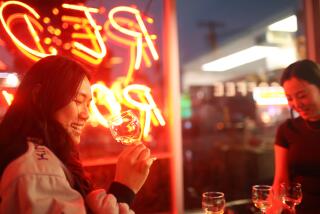In Lisbon, the night is forever young
- Share via
Reporting from Lisbon — Arriving in a new European city is exhilarating at any time of day, but I have always been more intrigued by the first nightfall. Dusk, to be precise. It’s that time -- as the sun descends and the shadows of buildings inch forward ominously -- when you take one last squint at your guidebook and think, “Is it going to be the hotel bar or the great unknown?”
In Lisbon, I chose the latter. Here, in Portugal’s 33-square-mile hilly capital city, the day is done when you see old women yanking the colorful laundry off the lines that hang outside their windows. But I soon learned that the onset of night is actually Lisbon’s awakening.
“We’re a nocturnal people,” says Pedro Souto, a Web designer who co-curates an annual horror film festival called MotelX in Lisbon. “Everything starts late here. You don’t go to the bars until midnight and then to nightclubs at 3 or 4 a.m.” (I got the sense that he wouldn’t be visiting L.A. after I explained to him that our bars and clubs close at 2 a.m.)
It’s easy to understand why young Lisboêtas go out for a stiff espresso, or bica, in the Chiado district at sunset. This neighborhood of mostly cobblestone streets is known for its fashion boutiques and coffee culture. If New York is the city that never sleeps, Lisbon is the city that rarely yawns.
Over at the bohemian Vertigo café at about 8 p.m., the scene is artsy and antsy. Photographers, writers and musicians table-hop, while jazz ballads play softly. Java-intolerant? The pineapple-mint smoothie makes an energizing alternative.
Owner Sofia Landeau told me that she wanted to create a tertulia, or salon-like gathering for artists, when she opened the cafe five years ago on a narrow side street.
“This area is known for the old cafes, where writers and artists used to sit around and talk about their work,” she said. “That’s what people do here now too.”
Around the corner, locals and tourists alike share the alfresco seating at the 104-year-old Café A Brasileira. Find it by looking for the bronze statue of the Portuguese poet Fernando Pessoa, which attracts a cluster of shutterbugs. (FYI: A bica inside at the antique wooden counter costs less than half the price of a coffee at an outside table, and you’ll get served faster.) For a more low-key vibe, you can head to a favorite journalists’ haunt known as Café No Chiado. Inside, the bookish atmosphere and bright emerald walls encourage heady discussions about the disappearance of poetry or our lack of modern-day philosophers.
By 10 p.m., it’s about time to stroll to dinner. Thank goodness Lisbon’s center city is compact enough that you can walk from district to district to sample the specialties. Caveat: The hills can be merciless, and wearing high heels is as sensible as smooching a shark.
In the nearby Baixa, or downtown district, you can pick from half a dozen seafood restaurants that line one street, Rua das Portas de Santo Antão. Gambrinus, with its masculine leather chairs and white tablecloths, is as old-school macho as Musso & Frank. The shellfish bisques are the specialty here. Strides away, it’s much more boisterous at Solmar, a cervejaria -- or beer hall that serves surf and turf -- with a giant mosaic mural of sea life that contrasts nicely with the real spindly creatures in the scattered tanks. Pick your lobster and wash it down with the local pale lager Super Bock.
In the nearby labyrinthine Bairro Alto neighborhood, dozens of bars -- I counted 19 on one street -- are just starting to simmer at 11 p.m. Amid the pub-crawl mecca is Pap’ Açorda, a hyper-fashionable restaurant named for the region’s hearty bread and shellfish stew. The dining room is all white, which makes a perfect palette for its clientele of politicians, fashion editors and celebrities. Giant Murano chandeliers add sparkle.
Step outside at midnight, however, and it’s suddenly Mardi Gras. Hundreds of twenty- and thirtysomethings spill from the bars onto the streets of the Bairro Alto and congregate or cruise the scene. To get a mental picture, just imagine the Sunset Strip as a block party on a Saturday night. Hips collide, drinks splash and flirtations ensue.
At Capela, a favorite lounge in this neighborhood, the vibe is more jazz club than rowdy bar. House wines are served in pebbled glass goblets that lend a chi-chi civility, and the mismatched Art Deco lighting throws out a warm, sexy glow. A few streets over, ZDB is a raw arts space devoted to resident DJs and live music. It gets loud and sweaty.
Music, in fact, can be heard throughout the district. Wander down a street and you’re bound to drift through a smorgasbord of sounds, from Latin rhythms to heavy metal to techno trance beats. Souto notes that music is at the heart of Lisbon’s raging night life, which first ignited in the 1980s and began to flourish in the ‘90s. “Maybe we stay out all night because this culture is still new for us,” he adds, with a shrug.
Portugal’s own musical genre known as fado -- or fate -- is hardly novel, though. This plaintive, melancholy sound dates to the 1800s, and if you visit Lisbon, you can’t leave without experiencing it. For the best fadistas, or singers, head to the old neighborhood known as the Alfama district, where restaurants offer live performances without stages or microphones.
It’s best to have a plan before you enter this dark, narrow neighborhood, which can be as confusing as a garden maze. Many restaurants consider your dinner to be the admission price until 11 p.m.; a drink minimum comes into play for those who arrive later. Dinner reservations are key, especially because fado is back in vogue with the younger set.
Mesa de Frades, housed in a former palace chapel, couldn’t be more quaint and intimate with its 30-odd seats and tiled walls. Traditional Portuguese fare such as bacalhau (salted cod) or bife (sliced steak in red wine sauce) work well with the delicious Douro table wines, akin to a mild Bordeaux.
At midnight on a recent Saturday night, the heavy doors were shut, the lights were lowered and the famed fadista Ana Sofia Varela stood up to sing a set of sorrowful ballads in the candlelight. Sadness and longing overtook the room.
“I pick songs and lyrics that have something to do with my life,” Varela says after her performance. “But I can’t tell you what I am thinking about when I sing the melancholy songs. It’s too personal.”
After Varela’s set, the doors are thrown open for a break, and then a few other fadistas follow. It all feels very impromptu, almost like a comedy club. Other nearby notable fado houses include Parreirinha d’Alfama and Clube de Fado.
Come 2 a.m., many fado houses close and much of the Alfama shuts down like a factory on Christmas. Now, yet another crucial decision must be made: hotel bed or the great unknown. I stifle a lion-sized yawn and, once again, choose the latter.
Just a short cab ride away, across from the Santa Apolónia train station, you will find Lux. Ask any hip Lisboêta for a night-life recommendation and this mammoth club, partly owned by John Malkovich, is named with reverence. At 3 a.m., a line of 50 or more hopeful revelers snakes around the building. To get in, approach with confidence and murmur something about craving a glass of Moët.
Inside, the first floor serves as a packed dance hall that is not for the claustrophobic. Upstairs, settees abound, and everyone lounges like aristocrats in a John Singer Sargent portrait. The vibe is congenial, though, and you won’t get that frosty Hollywood once-over from anyone. A roof deck, with a giant bed, makes the perfect perch for stargazing or, ahem, a quick catnap.
At 5 a.m. -- just an hour before closing -- I chose the latter.
More to Read
Sign up for The Wild
We’ll help you find the best places to hike, bike and run, as well as the perfect silent spots for meditation and yoga.
You may occasionally receive promotional content from the Los Angeles Times.






